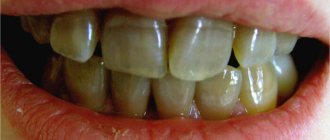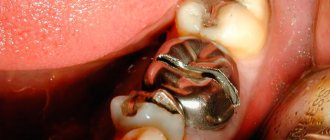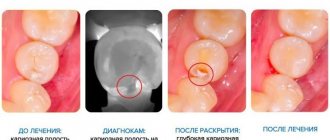What is a porcelain crown?
Porcelain crowns are products made from pressed ceramics that are completely free of metal impurities. They are made using porcelain, which is produced using the method of pressed casting followed by firing. Crowns obtained in this way are much better in elasticity than metal-ceramic crowns. Today, porcelain teeth are one of the most common in orthopedic dentistry. Although they are less durable than their metal counterparts, their popularity is due to their improved aesthetics.
Tooth restoration with veneer
A veneer is a thin overlay on the front surface and cutting edge of a tooth. A veneer allows you to adjust the shape of a tooth and give it the desired relief, transparency and color.
Unlike crowns, inlays and fillings, which are installed solely for medical reasons, patients often want to get veneers simply to make their teeth more beautiful .
It should be noted that it is not always possible to install veneers without prior treatment and there are a number of contraindications. We will tell you more about veneers in another article.
In addition to the term “veneer,” there are several other names (lumineers, ultraneers, nanoeers), which essentially mean the same method of aesthetic dental restoration.
So, we remembered in what cases the doctor suggests restoring teeth with a crown, inlay and veneer. Each orthopedic design has its own indications and contraindications, and during the consultation, after X-ray diagnostics, the doctor will explain in detail why he recommends this or that method of tooth restoration.
And now it’s time to figure out why ceramics make orthopedic structures aesthetically superior.
Types of porcelain crowns
Based on their location in the row, artificial teeth are divided into anterior and lateral. According to the characteristics of attachment to the base, the following types of porcelain teeth are distinguished:
- Crampons . A crampon is an element made of metal wire for fixing a tooth. The metals used for their manufacture are different, but most often we use an alloy of silver and palladium.
- Diatoric . They are hollow inside and for this reason they are also called perforated. The front teeth are mainly equipped with crampons, but they can also be hollow inside, but the lateral ones are made diatoric.
Crowns, called “da Vinci”, also consist of porcelain, but thanks to the special technology used in their manufacture, they have the ability to transmit a stream of light through them. In the light they look exactly like natural human teeth.
Causes of dystopia
Genetic and exogenous factors can provoke dental dystopia, but most often the pathology develops in the embryonic period. The main causes of the disease are:
- Disturbances in the formation of primordia during intrauterine development of the fetus.
- Development of dystopia against the background of other pathologies (crowding, macrodentia, adentia, disproportions between primary and permanent teeth).
- Untimely removal of a baby tooth or problems with teething. For example, canine dystopia can develop if they erupt late.
Advantages and disadvantages
The main positive aspects of using porcelain crowns in dental prosthetics include their complete identity with natural human teeth. Due to their hardness and excellent appearance, they are quite popular among visitors to dental offices. At the same time, analyzing the positive and negative aspects of these crowns, one cannot fail to mention a number of disadvantages:
- the inherent fragility of ceramics;
- insufficiently tight fit to the gum and tooth;
- high degree of abrasiveness, which affects the contacting teeth;
- the relative high cost of such artificial teeth compared to polymer and metal ones.
The lack of an ideal fit at the attachment points forces dentists to operate on a larger area in the patient’s oral cavity; in addition, deterioration in the strength of the attachment can correspondingly affect articulatory properties.
Indications for the use of veneers
Indications for the use of veneers
- Changes in tooth color (discoloration);
- Tooth surface defects – stained cracks, non-carious lesions extending beyond the middle of the vestibular surface;
- The presence of gaps between teeth with a sufficient area of remaining healthy enamel and refusal of orthodontic treatment;
- Dental trauma;
- Abrasion along the cutting edge.
Indications and contraindications
Indications:
- Due to the excellent appearance of porcelain teeth, as well as the biological inertness of porcelain for the human body, it is ideal for patients with hypersensitivity to polymers.
- Until recently, there was a point of view that metal-free ceramics were only suitable for the front teeth, since the chewing lateral molars took on the increased load associated with chewing food. Today, porcelain is used not only as crowns of individual front teeth, but also for prosthetics of lateral chewing teeth.
- Dental porcelain dentures are required in cases where complete tooth destruction has occurred or there is a need to restore several adjacent teeth at once.
The installation of porcelain crowns is contraindicated if the patient:
- Advanced periodontal disease was detected
- The hardness of dental tissues is insufficient
- Malocclusion
Phenomena occurring before teething
- hypoplasia, enamel hyperplasia
- endemic fluorosis;
- anomalies of tooth formation;
- color anomalies;
- genetic disorders.
Enamel hypoplasia is a disorder that is caused by changes in the cells from which enamel is formed. In these cells - ameloblasts, a change in mineral metabolism occurs and the trophism of hard tissues is disrupted. It develops in the fetal state or in childhood. It entails deformation of the pulp, dentin, and provokes malocclusion. Enamel hypoplasia affects up to 14% of all children.
Enamel hyperplasia involves excessive development of tooth tissue. Most often observed on the neck of the tooth, it may affect the contact surface of the teeth. Enamel hyperplasia does not cause functional impairment, but the orthopedist will have to take this feature into account when creating metal-ceramic and porcelain prostheses.
Dental fluorosis is considered a chronic disease that is caused by excess fluoride intake. As a rule, it occurs when drinking water containing a large amount of this element. Fluoride removes calcium from the body, as a result of which the mineralization of teeth is disrupted, they become fragile, and various associated anomalies appear.
Anomalies of hard dental tissues can be hereditary. This is due to diseases affecting the development of enamel and dentin. Often accompanied by changes in the color and shape of teeth.
Treatment of hypoplasia
Treatment for hypoplasia may vary depending on the degree of the disease and consist of bleaching and other measures, as well as remineralization therapy and subsequent prevention. Hyperplasia is the excessive formation of tooth tissue, in which so-called enamel drops of different sizes are formed, often located at the border of enamel and root cement in the neck area, less often in another place. Treatment is most often not required, but if the pathology has affected the front teeth, grinding and thorough polishing of the tooth surface can be used.
Endemic fluorosis
Endemic fluorosis is a lesion of hard tooth tissue due to the consumption of water containing more than 2 mg/l of fluoride compounds. In this case, treatment is prescribed depending on the period of residence of the patient in the area in which such water is used, as well as on the diet and social situation. It can consist of either remineralization of teeth in mild cases of disease, or restoration using composite materials or the use of orthopedic structures.
Anomalies of tooth formation
Anomalies in the formation and pathological processes during tooth eruption occur with developmental disorders in general, as well as diseases of the endocrine and nervous systems, and require complex treatment. Changes in tooth color depend on many factors - taking medications of a certain group, including by the mother during pregnancy, as well as other phenomena.
Life time
According to practical observations, porcelain crowns are quite capable of serving their owner from 10 to 15 years. At the same time, a number of factors can shorten their service life.
- Porcelain is a rather fragile material. Therefore, a small crack in the crown may well grow over time, leading to its complete unusability.
- Please note that artificial crowns wear out faster in people who have the habit of clenching their teeth tightly. The slightest destruction of the tooth allows caries to penetrate under the surface of the crown, which cannot harm the crown itself, but will accelerate the destruction of the tooth underneath.
If you feel that the porcelain crown has become loose or is subject to displacement when chewing food, you should under no circumstances try to install it yourself! To resolve this problem, a visit to an orthopedic dentist is necessary.
You can get crowns on your teeth in Moscow at a cost-effective rate at Dantistoff Scientific Dentistry. Orthopedic dentists, candidates of sciences of the highest category. Sign up.
Tooth restoration with a crown
A crown is used to restore severely damaged and lost teeth.
If the tooth is no longer present, the crown is placed on a dental implant. We talk about this type of treatment in the article Implantation - fast, reliable and aesthetic dental restoration.
Why should you listen to the doctor’s recommendation if he suggests installing a crown and not a filling, as patients sometimes insist?
Main indications for crown installation:
- the crown part of the tooth is destroyed by more than 50%
- large, previously installed fillings require replacement again
- a “dead” (pulpless) tooth that becomes fragile because its tissues do not receive nutrition. For comparison, imagine how much stronger a “living” tree branch is than a dried one.
Ignoring the doctor’s recommendations can lead to the fact that the tooth restored with a filling will not withstand the chewing load and will decay even more.
And if the tooth splits and the crack goes under the gum, then the remains of the tooth will need to be removed and an implant installed.
Watch video clips illustrating the described situations.
Manufacturing stages and technology
When taking individual measurements to prepare an artificial crown, up to one millimeter of tissue is removed from the surface of the tooth. This is necessary so that the crown sits firmly on the tooth. Next, the color of the tooth is determined, on the basis of which the color of the porcelain crown will be selected according to the international color scale, where shades are designated by numbers from 1 to 9.
Platinum foil with a thickness of 0.2 - 0.25 mm is used as a matrix or mold to create the workpiece. This material is preferred because its thermal properties are close to those of porcelain mass. The main stages of making porcelain crowns will be as follows:
- preparing the matrix and then installing it on the resulting model;
- filling the matrix with porcelain mass;
- firing of the resulting crown.
When making porcelain crowns for teeth, the workpiece is fired in the first two stages.
- The first firing is the heat treatment of the inside of the crown, and at this stage possible cracks are eliminated.
- The next stage of vacuum firing makes it possible to obtain a preliminary crown shape. Here the workpiece is adjusted to the required dimensions, giving the tooth individual properties in the form of cracks and stains.
- Correction of the finished tooth is completed by staining it with the selected dye.
- The final production stage will be glazing the finished crown.
Patients are often interested in technology such as porcelain coating on teeth. This formulation is not entirely correct. We are talking about installing thin porcelain ceramic overlays, also called veneers. They are inferior in service life to porcelain crowns and are more susceptible to chipping.
Cost of installing veneers
The final cost will be calculated by your doctor after the first consultation. The examination, drawing up a treatment plan and cost estimate are free of charge. The price for installing veneers depends on the number of onlays and the need to pre-treat caries. X-ray diagnostics, taking impressions and computer modeling are paid separately.
Initial consultation
- Oral examination
- Making a treatment plan
- Drawing up a treatment estimate
For free
Cost of installing a veneer (1 tooth)
- Anesthesia and pain relief
- Modeling teeth on wax
- X-ray images
- Computer smile modeling
- Tooth treatment
- Taking impressions
- Making a veneer
- Veneer installation
The final cost depends on the material you choose
from RUB 20,990 to RUB 31,000
Production is kept secret and is carried out only in the Cerinate laboratory, which determines the considerable price of porcelain veneers - they are much more expensive than ceramic and composite ones. Ready-made onlays are placed on the teeth using super-strong cement. With proper care, they last up to 20 years.
Since lumineers are thin, they cannot mask serious imperfections or correct enamel color that is too dark. The installation technology without grinding is mainly suitable for patients with small teeth, because adding extra thickness can have a negative impact on aesthetics. Porcelain veneers are used for:
- enlarged spaces between teeth;
- small fillings, minor cracks and mild pigmentation on the enamel;
- the patient’s desire to lighten the shade of the enamel by 1–2 tones;
- presence of cracks and chips on old ceramic crowns.
How to care
If a patient chooses porcelain as a material for teeth, then he must remember that such crowns require care in the same way as natural ones. Despite the fact that the tooth is relatively protected from destruction, the gum area is vulnerable. Thorough brushing of teeth with a quality fluoride toothpaste is still essential. Lack of proper dental care, for example, irregular brushing, simultaneous intake of cold and hot food can deteriorate the quality of the crown during its operation.
Comparison: plastic or porcelain teeth
It is important not to allow the porcelain crown to overheat during processing, as this can cause a crack to appear, followed by possible separation of part of it.
When comparing plastic and porcelain crowns, it is worth noting the advantageous aspects of polymer products:
- crowns made of plastic do not have the fragility that is inherent in porcelain;
- abrasive processing or grinding of plastic crowns is much easier;
- Reliability in operation of plastic teeth is determined by the ease of their installation.
At the same time, porcelain teeth are not subject to changes in their inherent size and shape. They do not soften or deform when exposed to temperature conditions. Porcelain products are less susceptible to abrasion of work surfaces due to their increased hardness. The same comparative criteria can be applied when choosing material for removable dentures.
Methods for making veneers
- Injection pressing followed by sintering of ceramic mass (Dicor, IPS Empress);
- Vacuum firing on a refractory model (refractor);
- Milling on a computer-controlled machine from ready-made factory blocks - CAD/CAM (computer aided design and manufacturing). These are systems such as Cerec, Everest Procera, Cercon and In-Ceram, Vollceram, Hi-Ceram masses.
Advantages and disadvantages of veneers
White teeth whitening pads
If the goal is only to change the shade of the enamel, dentistry uses the thinnest white overlays on teeth made of composite, as well as in the form of lumineers and ultraneers. Teeth whitening with onlays in this way is suitable only for those who have healthy enamel (or is slightly damaged). The lightening procedure itself using such plates is called restoration bleaching. It is used when traditional types of whitening, such as home, laser, oxygen and Zoom whitening, do not work. During installation, the onlays are attached to the facial surface of the front teeth. Whitening plates are not installed on chewing teeth.
If desired, the patient can always contact the doctor with a request to change the plates to new ones (of a different color) or remove them completely. Moreover, the cost of installing such onlays on teeth will be significantly lower compared to other types of restoration.
Veneer manufacturing sequence
Veneers require individual care! Avoid lever-like movements when biting food
- Determination of indications;
- Cleaning teeth from plaque, determining color;
- Photographic registration of images of the patient's face in front and profile with the mouth open and closed in the anterior region (this information helps the technician in planning future restoration);
- Taking diagnostic impressions and making models, recording central occlusion (habitual closure of the dentition);
- Wax planning of future restoration (WaxUp);
- Production of temporary veneers (if preparation is planned);
- Preparation with depth marking (the goal is to remove only the minimum volume of enamel necessary for applying and fixing the facets;
- Taking final working impressions, re-registration of central occlusion, temporary fixation of temporary structures made of composite or acrylic plastic;
- Production of veneers in a dental laboratory or milling center;
- Removal of temporary restorations;
- Application and fitting of the finished structure, assessment of quality, accuracy of marginal fit, contact with adjacent teeth and antagonists (teeth of the opposite jaw);
- Cleaning and preparing the tooth surface and veneers for permanent fixation;
- Isolation of the working field;
- Fixation with dual-curing composite cement (light and chemical);
- Removing excess material;
- Check and, if necessary, correct contacts.











